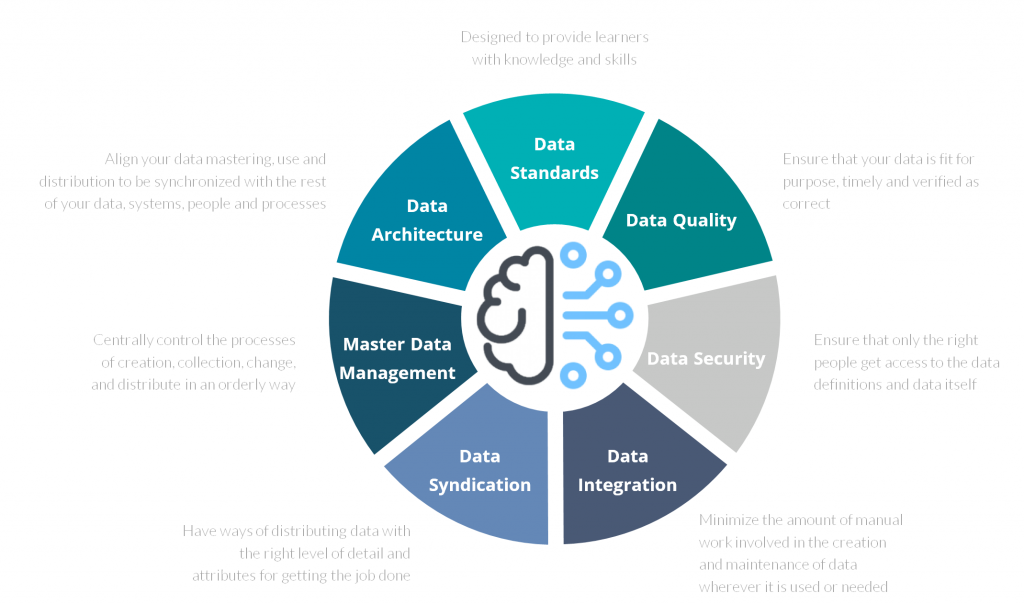Maintaining data quality and consistency is essential in the practice of effective customer data management, and with Pretectum CMDM (Customer Master Data Management), organizations have a powerful tool to achieve this goal.
Best practices in this context involve a comprehensive approach that addresses data quality at every stage, from initial data entry to ongoing maintenance.
Implementing a robust data governance framework is essential for maintaining data quality. By this we mean the defining of clear policies and procedures for data management, specifying data management responsibilities, and ensuring accountability across the organization. Such frameworks should encompass data stewardship, data ownership, and well-defined processes for data validation and correction.

As an example, the FAIR principles provide guidelines to improve the Findability, Accessibility, Interoperability, and Reuse of digital assets. In 2016, the ‘FAIR Guiding Principles for scientific data management and stewardship’ were published in Scientific Data, these principles aim to enhance the ability of both humans and machines to find, access, interoperate, and reuse data with minimal human intervention.
Any framework that you might consider should provide the following traits that meet business needs and expectations and ultimately drive business behaviors.
- Alignment: Standardizing customer data collection across the organization.
- Validation: Ensuring data is collected properly.
- Enforcement: Managing changes to data collection to maintain data integrity
Other aspects of a robust DG framework will also cover off topics like data quality and data security; data integration and avoiding data silos; meeting compliance objectives with data protection and privacy regulations where mandatory. This includes managing customer consent, minimizing data collection, and conducting regular audits to ensure compliance.
The presence of a data management plan will outline how data will be collected, organized, stored, and used. It includes details on data types, sources, formats, management methods, roles, and responsibilities and often drive toward creating a centralized repository for all customer data ensures consistency and accuracy across the organization. This repository acts as a single source of truth for all customer interactions.
Establishing policies for data retention, archiving, and destruction throughout the customer data life-cycle helps manage data effectively and ensures compliance with various local, national, industry and international regulatory requirements and also providing tools for customers to manage their own data enhances data accuracy and compliance, and empowers customers to have control over their information.
The continuous monitoring and updating customer data ensures it remains accurate and relevant, which is crucial for effective decision-making and customer relationship management.

The Pretectum advantage
Within Pretectum CMDM you can establish standardized procedures for data entry to ensure consistency from the outset. You would use data validation rules to enforce data standards and prevent the entry of inaccurate or incomplete information. This includes validation checks for data types, formats, and relationships to maintain a high level of accuracy.
Regularly conduct data cleansing activities to identify and rectify errors or inconsistencies in customer data. Leverage Pretectum CMDM de-duplication capabilities to eliminate redundant records, ensuring a clean and streamlined database. This process enhances the overall accuracy of the customer data and reduces the risk of errors in downstream processes.
Implement automated data quality monitoring tools within Pretectum CMDM to continuously assess the quality of the data. Set up alerts and notifications for data anomalies, ensuring that any issues are promptly addressed. Through the power of automation you could allow your organizations to maintain data quality in real-time, preventing the propagation of inaccuracies across systems.
Emphasize your organization’s metadata management to provide context and meaning to the data stored in the Pretectum CMDM. Document your data definitions, the data relationships, and the business rules associated with customer data entry and capture. A well-managed metadata repository in your CMDM enhances employee and business partner data understanding, facilitates effective communication, and contributes to maintaining data consistency.
Define key data quality metrics and Key Performance Indicators (KPIs) to measure the effectiveness of data quality efforts. Regularly monitor and report on these metrics to assess the overall health of the customer data. This not only provides insights into the success of data quality initiatives but also guides continuous improvement efforts.

Provide comprehensive training to users in how to use the Pretectum CMDM to ensure they understand the importance of data quality and the value of a single source of truth. Centralizing your customer master data management fosters a culture of data stewardship and ownership, where users actively contribute to maintaining the accuracy and consistency of customer data. Running regular awareness programs can also reinforce the significance of data quality across the organization. Using this one system simplifies the end-to-end process and experience.
You can establish seamless integration between Pretectum CMDM and your source systems to ensure that updates and changes are synchronized in real-time. This integration minimizes the risk of discrepancies between systems and guarantees that the data within Pretectum CMDM remains aligned with the most current information from various sources.
Incorporate robust data security measures via the RBAC concept to protect customer information within Pretectum CMDM. Ensure compliance with data protection regulations by taking advantage of the encryption, access controls, and audit trails within the platform. A secure environment not only safeguards sensitive data but also contributes to the overall trustworthiness of the customer data.

Verbose and comprehensive auditing capabilities supports regularized audits and quality checks on the data stored in Pretectum CMDM. These checks could include data profiling, anomaly detection, and validation against predefined rules. Regular assessments would help identify emerging issues and provide opportunities for proactive data quality improvements.
Maintaining data quality and consistency with Pretectum CMDM provisions a holistic and proactive approach. By combining a robust data governance framework, standardized processes, automation, and continuous monitoring, you can ensure that your customer data remains accurate, reliable, and aligned with business objectives.
These best practices not only enhance the effectiveness of Pretectum CMDM but also contribute to the overall success of customer-centric initiatives within your organization.
Contact us to learn more


